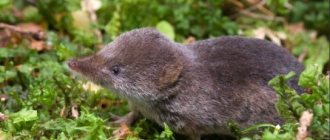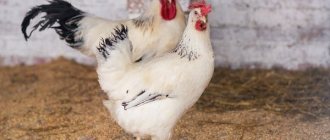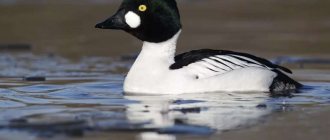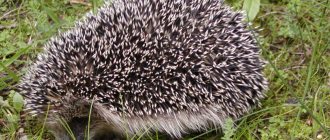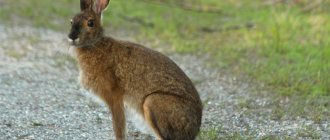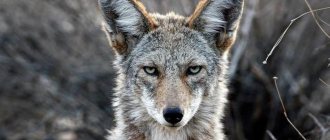- Wild animals
- >>
- Mammals
The shrew (Sorex) is a small insectivorous animal from the shrew family. They live on all continents in the northern hemisphere, mainly in forests and tundra. This genus includes the winners in the categories “smallest” and “most voracious” among mammals. They challenge Bergman's law and demonstrate the Danel effect. In total there are about 70 species in the genus, of which 15–17 species are in Russia.
Origin of the species and description
Photo: Shrew
The Latin name of the genus comes from a word meaning “whisper, chirp, buzz.” This refers to the sounds that animals make during collisions with each other. The Russian name of the genus is given for the reddish-brown color of the tops of the teeth.
The types are distinguished based on the structure of the teeth, which is quite difficult for a non-specialist. The taxonomy is poorly developed; today there are different classifications, according to one of them there are three subgroups.
Video: Shrew
But according to another - four:
- species of unknown origin, including the tiny shrew (Sorex minutissimus) - indeed, the tiniest mammal in Russia and the second in the world, smaller than only the dwarf shrew (multi-toothed shrew) from the same shrews;
- subgenus Sorex, which includes the common shrew, also known as the shrew (Sorex araneus) - the most common and typical representative of the genus and the most numerous mammal of northern Europe;
- subgenus Ognevia with the only, but largest, representative - the giant shrew (Sorex mirabilis);
- The subgenus Otisorex includes mainly North American species and the smallest native mammal, the American pygmy shrew (Sorex hoyi).
The fossils date back to the Upper Eocene, the time when modern orders of mammals appeared.
How to get rid of it: effective methods
There are many ways to control rodents in the garden. The same methods can be used to combat shrews. Since these mammals are not specifically interested in the vegetable garden or garden, they can disappear as quickly as they appear. In addition, they can return at any time. These are not mice that practically live in the garden and garden for years, because there is enough food for them here, but in the winter they begin to attack human homes. At the same time, they can eat something that can hardly be called edible. As for shrews, they lead a completely different way of life. If the mouse is a serious pest, then the shrew is most likely a garden nurse. To combat it, it is enough to use traditional methods, traps or repellers.
Chemicals
The advantage of chemical control agents is that they are effective. The principle of action of chemicals is based on poisoning animals, which leads to their death. The disadvantage of such drugs is that they are poisonous and they do not care who they poison, an animal or a person. In this regard, many owners try not to get involved with toxic substances.
As a last resort, you can use:
- Hunter Antirodent.
- The Nutcracker.
- Rat death.
Physical methods of struggle
Considering the fact that the shrew is more useful than harmful, more humane methods of control can be used in relation to it. As an option, it is permissible to install ultrasonic repellers. Such devices operate at a distance of up to 30 meters, and some models - at a distance of up to 1 km.
In addition to such devices, you can use traps that work on the principle of mousetraps. The most preferable option is live traps. Such traps are made in the form of a pipe, on both sides of which there are dampers that open only inward.
Appearance and features
Photo: What does a shrew look like?
At first glance, the animals look like mice, but they belong to a completely different order - insectivores. Upon closer examination, the body structure is noticeably different from that of a mouse. First of all, the relatively large head with a muzzle elongated into a flexible proboscis catches the eye. The animal constantly moves it, sniffing and looking for prey. The ears are tiny and practically do not protrude from the fur. The eyes are microscopic and completely expressionless.
If we consider them a mirror of the soul, then the shrew has almost no soul - all the animal’s thoughts are only about its daily bread. But such small animals cannot do otherwise, they lose too much heat compared to large ones, they constantly require energy replenishment of metabolic processes, which go on at breakneck speed. “The less weight, the more food” is a general rule for all warm-blooded animals. Babies have 32 teeth, like a human, but the incisors, especially the lower ones, are very long. Milk teeth are replaced by permanent ones even in the embryo, so that the animal is born fully equipped with all teeth.
The body length (without tail) in different species can range from 4 cm in a tiny shrew to 10 cm in a giant shrew; weight ranges from 1.2 - 4 g to 14 g, respectively. The average size, for example, of a common shrew is 6–9 cm plus a tail of 3–5.5 cm. The body is covered with velvety thick fur sticking out vertically, so the shrew cannot be stroked against the grain. The color of the fur on the upper side is reddish, brownish or grayish and camouflages the animal well on the ground; on the lower side the body is light gray.
The tail can be either very short or almost equal to the body, covered with sparse hairs. There are usually glands on the sides and base of the tail that secrete a pungently smelling musky secretion that protects the shrew from predators. Females have from 6 to 10 nipples. In males, the testes are located inside the body, and the copulatory organ can reach 2/3 of the body length.
Interesting fact: The shrew's skull is like an elongated triangle - it has a greatly expanded brain section and narrows towards the nose, so that the jaws look like tweezers. By winter, the skull decreases, reducing the volume of the brain, and in summer it increases (the so-called “Danel effect”). The brain makes up 10% of the weight of the entire animal and this ratio is greater than that of a human or even a dolphin. Apparently, the constant need to solve problems with food contributes to brain development.
External characteristics
There are many species in the shrew genus, more precisely, about 130. The differences between the animals lie in size and habitat. Well, some slight variations on the theme of color. A characteristic feature of the animal is its long body parts, namely the tail and muzzle.
Body length 5-10 cm, tail – 3-8 cm, weight 2.5-15 g. The fur cover is short-haired, from dark gray to brownish. The bellies of almost all species are light. The tail is slightly hairy, with short pile, except for the flat-skull variety, in which it is quite fluffy.
The tips of the animal's teeth are red-brown. This became the determining factor in the name. But with age, the tops of the teeth wear off, and nothing remains of the unusual color. The small ears on the head are almost invisible from under the fur. The beads of the tiny, round eyes are black. But in general, the shrew’s eyesight is weak (due to its underground existence), so the main organ in search of food becomes the nose, whose powerful sense of smell perfectly captures odors. The shrew is also quite good at echolocation.
Shrews of this species are one of the oldest creatures on the planet belonging to vertebrate mammals. Their jaws are clearly divided into canine, incisor, molar and anterior teeth. The shrew leaves behind a small chain of paired tracks. On the soft snow cover, a clearly defined path is visible from the tail.
Nature has rewarded the rodent with a bright musky smell. Therefore, even after catching an animal, many predators do not eat it.
Where does the shrew live?
Photo: Shrew in Russia
The range of the genus covers mainly the subarctic and temperate zones of all continents of the northern hemisphere. In more southern regions, such as Central America or Central Asia, shrews are found in the highlands.
A typical representative, the common shrew, is the most versatile and adapted to life in a wide variety of natural zones from the northern tundra to the lowland steppes, where it chooses floodplains and tall grass meadows for settlement. The animals do not like open places and cannot tolerate direct sunlight - their favorite habitats are always shady and damp. In winter they live under a layer of snow, practically never coming to the surface.
In central Russia, common shrews are found everywhere in forests and parks, especially cluttered ones, with dense undergrowth and a thick layer of forest litter. They live along the banks of stagnant bodies of water in thickets of coastal vegetation, near swamps. But they are also common in cultivated summer cottages, which is confirmed by cats bringing them as prey. They are especially drawn to human habitation on the eve of winter, when they can even climb into houses.
Interesting fact: The smallest species live in the tundra and highlands and endure the fierce frosts of central Siberia, although it would seem they should strive for warm places. Moreover, studies of the American ash shrew (Sorex cinereus) have shown that the body size of the animals decreases the further north they live. This contradicts Bergmann's well-known rule, according to which the size of individuals in cold areas of the range should increase.
Now you know where the shrew is found. Let's see what this animal eats.
What does a shrew look like: photo
Shrew.
Name: Shrews Lat.:
SorexClass: Mammals - Mammalia Order: Insectivores - Eulipotyphla or Lipotyphla Family: Shrews - Soricidae
| Habitats: | shaded areas of forests and steppes |
| What it eats: | small insects, bugs |
| Description: | carnivorous mammals that do more good than harm |
What does a shrew eat?
Photo: Shrew from the Red Book
When searching for food, shrews are guided by a keen sense of smell and keen hearing; some species use echolocation. Animal food, as the most high-calorie food, forms the basis of the diet. The shrew eats everything it can catch and chew with its exceptionally sharp teeth - needles.
It can be:
- any insects at all stages of development, Coleoptera, Diptera and Lepidoptera, with more larvae being eaten;
- spiders;
- earthworms;
- mollusks, including slugs, to which shrews owe worms;
- other invertebrates; for example, nods, which are eaten by the giant shrew;
- baby mouse-like rodents;
- small amphibians;
- carrion, such as a bird or mouse;
- in extreme cases, he engages in cannibalism, even eating his own children;
- in winter it consumes plant foods, in particular coniferous seeds, which can make up up to half of the diet;
- also eats mushrooms and droppings.
In search of food, it makes narrow branched passages in the snow. The amount of food eaten per day is 2 to 4 times more than the weight of the animal itself.
Nutrition
A giant shrew manages to eat about a hundred times a day. I manage to sleep about 70 times. If you have to starve, the animal dies from exhaustion within a day. Even 3 hours can become critical. Therefore, shrews are “in business” in any weather, time of year, and day.
In contrast to mice, shrews have little plant food on their menu. The main diet is insects and worms. A special delicacy is kivsyaki. This is what centipedes are called. Millipedes and earthworms account for 95% of the rodent's diet. It becomes clear why the animal loves wet areas and deciduous forests.
Their falling and rotting greenery forms the soil favored by worms. Sometimes giant shrews catch small reptiles. Unlike other shrews, giant shrews are able to penetrate even compacted soil for food. The strength of the larger, stronger front legs plays a role.
Features of character and lifestyle
Photo: Common shrew
Our closest neighbor in the natural world is the most studied - the common shrew. Using her example, let's look at how these animals live and what they do. The shrew is agile and agile. Despite her weak legs, she cheerfully makes her way through the grass and loose forest floor, snoops under fallen bark and brushwood, can climb tree butts, swim and jump. She does not dig holes, but uses other people's underground passages, not being interested in the owner's opinion. The greedy baby is driven by the demands of the stomach and death from hunger is more real for her than from the teeth of a predator. Without food, it dies within 7 - 9 hours, and smaller species - after 5.
The animal spends more than half of its time, 66.5%, in motion and continuously searching for food. After eating, he sleeps, and after sleeping, he goes in search of food and such cycles during the day can be from 9 to 15, the slightest delay in this cycle will cost him his life. During the search, he covers up to 2.5 km per day. When food supplies are depleted, it moves to other places.
In autumn, and especially in winter, the shrew reduces activity, but does not hibernate. The baby simply cannot accumulate enough reserves for wintering and is forced to spin around even in frosty weather. It's amazing that she even survives until spring. Molting occurs in April - May and September - October, like all inhabitants of places with a seasonal climate. In winter, the skin becomes lighter. The sounds can be identified as squeaking, chirping or thin chirping. They are emitted mainly during a meeting and the fight that follows it.
Interesting fact: The tiny shrew eats 120 times every 10 to 50 minutes during the day. However, it lives in a colder zone of Eurasia than the common shrew.
Description of the animal
The common shrew is a member of the shrew family, which is very widespread in many countries. She is the largest of the family members.
Appearance of the animal
Giant shrew.
The shrew looks very much like representatives of the mouse family, but has an oblong muzzle that looks like a proboscis. The body length of an adult animal is 5-8 cm. The tail can reach 6-7.5 cm in length.
Sometimes it is covered with sparse hairs. The weight of the mammal ranges from 4 to 16 grams.
The fur of the animal on the back is dark brown, almost black. The fur on the belly is light brown, sometimes off-white. The color of young individuals has a lighter shade. The ears are small and densely covered with fur.
Shrew lifestyle
Animals of this species are active mainly at night. During the day, shrews can go out in search of food only in a safe place where they can hide without problems. Animals most often move on the ground and do not rise to higher ground unless absolutely necessary.
The animals are quite nimble and can jump to a height of 10-15 cm. Shrews do not hibernate and continue to search for food all year round. During cold weather, animals seek shelter under snowdrifts, where they also find food.
Despite popular belief, the shrew does not dig. The animal's paws are not intended for these purposes. She is only capable of looking for insects in the upper, loose layers of soil, using her “proboscis”. The animal often uses ready-made burrows.
What does a shrew eat?
These small mammals are predators. They devote most of their time to searching for food. The animal's constant feeling of hunger is explained by its very fast metabolism.
In summer, the main food for the shrew are:
- larvae;
- earthworms;
- insect pupae;
- butterflies;
- dragonflies;
- mouse-like rodents.
In winter, the animal's diet consists of insects that hibernate in the upper layers of the soil. Once in pantries and cellars, the animal does not spoil food supplies, but only looks for wintering insects.
These mammals consume plant foods extremely rarely. Only in the cold season can shrews supplement their meager diet with nuts or seeds from spruce and pine cones.
Reproduction of shrews
Tiny shrew.
The female shrew gives birth to offspring 2-3 times a year. One litter usually produces 7-8 cubs. The duration of pregnancy of an animal is 18-28 days. The animals are born blind and naked, but already 30 days after birth they are able to find their own food. The lifespan of a shrew is on average 18 months.
Reproduction of shrews occurs only in the warm season. Before the birth of the cubs, the female prepares a nest, which she covers with moss or dry grass. Animals choose old stumps, abandoned holes, or convenient depressions in the upper layers of soil as a place to build a nest.
Social structure and reproduction
Photo: Baby shrew
Shrews do not live together and when they meet, they show aggression, attacking each other screaming and emitting their signature smell. The male and female unite only for a short moment to mate, which in the common shrew can occur 3 or 4 times from April to October.
After the meeting, the female finds an old stump, hummock, trunk, empty hole or pile of brushwood and makes a nest from hay, moss or leaves. The nest is round with a cavity 8-10 cm in diameter. After about three weeks, the female gives birth to (3)6 – 8(11) children. The weight of the cub is about 0.5 g, length is less than 2 cm, it does not see, lacks hair and even a proboscis. But after 22–25 days, the new generation is completely ready for independent life, and the female is ready for new reproduction.
The young become sexually mature the following year, although the first spring litter is capable of breeding after three or four months. The rush is quite justified - super active animals live no more than 2 years. Which is common to all representatives of the genus.
Interesting fact: If the nest is in danger, the mother and young cubs of some species (common shrew, ashen shrew) form so-called “caravans” - the first child grabs the mother by the base of the tail, the rest similarly cling to each other. This is how they move around in search of safe shelter. There is another opinion that they are exploring the surrounding area, conducting “nature excursions,” so to speak.
Benefits and harms
Perhaps someone will consider the shrew to be a worthless animal, but in reality this is not the case. For humans, this animal can be very useful. Looking for food, shrews loosen the soil in gardens and vegetable gardens, which they do very well thanks to their unique trunk nose.
During the so-called “plowing” the soil is saturated with oxygen and at the same time cleared of harmful insects and larvae. But if you are used to seeing beautiful lawns, then, of course, the shrew will cause you a lot of trouble because of the constant minks that you will encounter on the site.
Shrews are incredibly useful creatures because they can reach many harmful insects in places that other insectivores and birds cannot reach. It is not difficult for them to find pests under stones, under snow and in the depths of burrows.
When you first meet these animals, they seem to be quite cute and fluffy creatures that are not capable of harming humans. However, if you try to catch this animal, they may bite, and the person may experience severe pain. Therefore, if you suddenly meet a shrew on your site, then forget about catching it or picking it up.
Natural enemies of shrews
Photo: Gray shrew
Everyone has enemies, even such angry and foul-smelling little ones. Some simply kill them, while others may even eat them if they do not have a good sense of smell.
This:
- mammalian predators, including domestic cats, which usually abandon their prey without eating it;
- owls that eat them despite the smell;
- hawks and other diurnal predators;
- storks;
- vipers and other snakes;
- predatory fish grab swimming animals;
- the shrews themselves are dangerous to each other;
- Parasites (helminths, fleas, etc.) cause a lot of harm to health.
Shrews usually coexist peacefully with people, although of course they can come under attack during terrorist attacks against mice and rats. However, people cause the greatest harm indirectly - by changing the environment through deforestation and urban development, and using pesticides.
Interesting fact: When studying one of the populations of the common shrew, 15 species of helminths belonging to round and flatworms were found in the tiny ones. One individual contained 497 different worms. Here is a typical example of harmony in nature!
Defense and population[edit]
Common and Eurasian pygmy shrew (genus Sorex
), size comparison
The common shrew is not endangered, but in the UK it, like other shrews, is protected from certain killing methods by the Wildlife and Countryside Act 1981. [15]
In the UK, the shrew is found in forests at densities of up to one per 200 m² (240 yd²). The main predators of shrews are owls, cats, weasels, snakes, stoats and red foxes. [5]
Population and species status
Photo: What does a shrew look like?
Population sizes of different species vary greatly. The most numerous and common species of Eurasia, the common shrew, can have a population of 200 - 600 specimens per hectare. The more food and hidden places for shelter, the greater the population density. Similar Eurasian ranges are found in the small, tiny, even-toothed shrews and many others. Large and densely populated habitats covering tundra and forest zones are characteristic of many American species.
Some species are more local, such as the Caucasian shrew, which inhabits the forests of the Caucasus and Transcaucasia, or the Kamchatka shrew from Kamchatka and the coast of the Sea of Okhotsk. But very rare ones, few in number and found in a small area, are not so common. Different countries have their own rarities.
The regional Red Books of Russia include:
- the tiny shrew (S. minutissimus) is protected in the Moscow, Ryazan, Tver, and Kaluga regions;
- the clawed shrew (S. unguiculatus) and the slender-nosed shrew (Sorex gracillimus) are included in the Red Book of the Amur Region;
- Radde's shrew (S. raddei) in the CC of a number of North Caucasian republics;
- The small shrew (S. minutus) is a Crimean rarity. Just in case, it is also included in the Red Book of Moscow as an indicator of forests preserved in an undisturbed state. Although in general the species is not threatened;
- The equal-toothed shrew (S. isodon) is protected in the Moscow region and Karelia. The range covers the forest zone of Eurasia from Scandinavia to the Pacific Ocean.
Chromosomal polymorphism[edit]
Chromosome number (karyotype) of Sorex araneus
varies widely, with a number of different "chromosomal races" present within the species' range.
[2] One such race was described in 2002 as a new species, S. antinorii
. [2] This is an example of chromosomal polymorphism (chromosomal variation resulting from the fusion or dissociation of chromosomes). [11] [12]
These carotypes are known to hybridize naturally, for example in the Petchora race and the Naryan-Mar variant in Northeast Russia. [13]
Notes
- Mammals. Large encyclopedic dictionary / scientific. ed. I. Ya. Pavlinov. - M.: ACT, 1999. - P. 36. - 416 p. — ISBN 5-237-03132-3.
- Sokolov V. E.
Five-language dictionary of animal names. Mammals. Latin, Russian, English, German, French. / under the general editorship of academician. V. E. Sokolova. - M.: Rus. lang., 1984. - P. 39. - 10,000 copies. - Hutterer, Rainer
. Soricomorpha. // Wilson, Don E., and Reeder, DeeAnn M. ed. Mammal Species of the World (3rd ed.). Baltimore: Johns Hopkins University Press, 2 vols. (2142 pp.). pp. 285-286. ISBN 978-0-8018-8221-0. OCLC 62265494. - Won, Byeong-o (원병오).
한국의 포유동물 (Hangugui poyudongmul, Mammals of Korea). - Seoul: Dongbang Media, 2004. - ISBN 89-8457-310-8. - Andrew T. Smith, Yan Xie (eds.)
A Guide to the Mammals of China. Princeton. 2008. 544 p. - ↑ Hutterer, Rainer
. Soricomorpha. // Wilson, Don E., and Reeder, DeeAnn M. ed. Mammal Species of the World (3rd ed.). Baltimore: Johns Hopkins University Press, 2 vols. (2142 pp.). pp. 285-286. ISBN 978-0-8018-8221-0. OCLC 62265494. - Sokolov V. E., Orlov V. N.,
Key to mammals of the Mongolian People's Republic M.: Science. 1980. 351 p. - A. Bekenov, P. M. Butovsky, B. B. Kasabekov and others.
Mammals of Kazakhstan. T. 4. Insectivores and bats. Alma-Ata: Science. 279 p.

